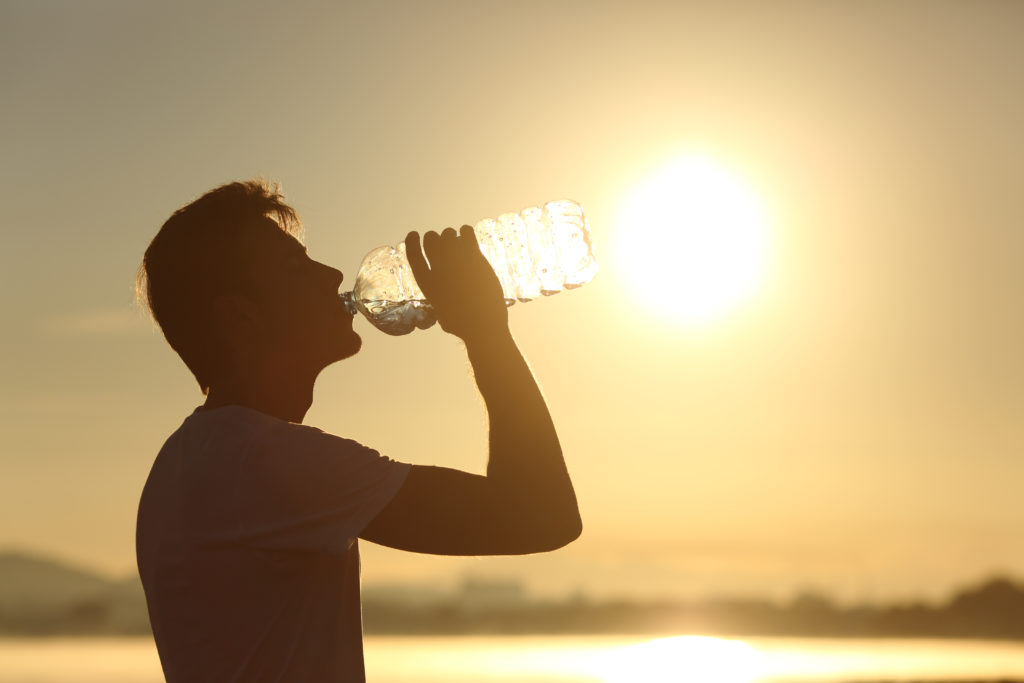Summer is here, and there are many ways for you and your family to enjoy yourselves and still stay safe and healthy. There are many topics to consider, including heat related illness, water safety, boating safety and biking safety.
Heat-related Illnesses
The human body is normally able to regulate its temperature through sweating, until it is exposed to more heat than it can handle. Heat exhaustion and heat stroke can escalate rapidly, leading to delirium, organ damage and even death. In 2019, 884 people died and 2,061 were injured in the U.S. from exposure to excessive heat, according to Injury Facts.
People most at risk include:
- Those who work in the heat
- Infants and young children, especially if left in hot cars
- People 65 and older
- People who are ill, have chronic health conditions or are on certain medications
- People who are overweight
Knowing the symptoms and proper response to these illnesses can save a life.
Heat Exhaustion
When the body loses excessive water and salt, usually due to sweating, heat exhaustion can occur. Signs and symptoms include:
- Pale, ashen or moist skin
- Muscle cramps (especially for those working or exercising outdoors in high temperatures)
- Fatigue, weakness or exhaustion
- Headache, dizziness or fainting
- Nausea or vomiting
- Rapid heart rate
Uncontrolled heat exhaustion can evolve into heat stroke, so make sure to treat victims quickly:
- Move victims to a shaded or air-conditioned area
- Give water or other cool, nonalcoholic beverages
- Apply wet towels, or have victims take a cool shower
Heat Stroke
Seek medical help immediately if someone is suffering from heat stroke. Signs include:
- Body temperature above 103 degrees
- Skin that is flushed, dry and hot to the touch; sweating has usually stopped
- Rapid breathing
- Headache, dizziness, confusion or other signs of altered mental status
- Irrational or belligerent behavior
- Convulsions or unresponsiveness
Immediately take action:
- Call 911
- Move the victim to a cool place
- Remove unnecessary clothing
- Immediately cool the victim, preferably by immersing up to the neck in cold water (with the help of a second rescuer)
- If immersion in cold water is not possible, place the victim in a cold shower or move to a cool area and cover as much of the body as possible with cold, wet towels
- Keep cooling until body temperature drops to 101 degrees
- Monitor the victim’s breathing and be ready to give CPR if needed
DO NOT:
- Force the victim to drink liquids
- Apply rubbing alcohol to the skin
- Allow victims to take pain relievers or salt tablets
The best way to avoid a heat-related illness is to limit exposure outdoors during hot days. According to the Centers for Disease Control and Prevention:
- Air conditioning is the best way to cool off
- Drink fluids, even if you don’t feel thirsty, and avoid alcohol
- Wear loose, lightweight clothing and a hat
- Replace salt lost from sweating by drinking fruit juice or sports drinks
- Avoid spending time outdoors during the hottest part of the day, from 11 a.m. to 3 p.m.
- Wear sunscreen; sunburn affects the body’s ability to cool itself
- Pace yourself when you run or otherwise exert your body

Keep Each Other Safe
In your community, please check in on neighbors who are elderly, house-bound or otherwise may be reluctant to ask for help. You can offer to host them in the air-conditioned comfort of your living room on hot days, drive them to a local cooling center, or call relatives or city services to arrange for them to stay cool.

Water Safety

Not including boating incidents, on average about 10 people die from drowning every day in the United States, according to Injury Facts® the annual statistical report on unintentional injuries produced by the National Safety Council.
While drowning deaths peak among one and two year olds, drownings continue to be the second leading cause of preventable death through age 15.
Swimmers should keep a few safety precautions in mind:
- Don’t go in the water unless you know how to swim; swim lessons are available for all ages
- Never swim alone
- Learn CPR and rescue techniques
- Make sure the body of water matches your skill level; swimming in a pool is much different than swimming in a lake or river, where more strength is needed to handle currents
- If you do get caught in a current, don’t try to fight it; stay calm and float with it, or swim parallel to the shore until you can swim free
- Swim in areas supervised by a lifeguard
- Don’t push or jump on others
- Don’t dive in unfamiliar areas
- Never drink alcohol when swimming; alcohol is involved in about half of all male teen drownings
Parents are cautioned all the time about water safety, but drownings still occur. Always be aware and be in the present moment with your children.
Every pool, every lake and every warm summer day holds the possibility of new, fun summer experiences. All you need to add is your undivided attention.
Boating Safety

Life Jackets Are Essential
Life jackets are at the core of safe boating, whether using a motorized or non-motorized vessel. Where cause of death was known, 75% of fatal boating accident victims drowned. Of those drowning victims with reported life jacket usage, 86% were not wearing a life jacket. While regulations on life jacket use vary from state to state, the Wear It program of the National Safe Boating Council promotes boating safety by encouraging boaters to wear life jackets any time they are on a boat, motorized or non-motorized. Good swimmers still need life jackets. When people fall off a boat, they may become disoriented, injured or unconscious. Life jackets can keep victims’ heads above water so they can breathe and be rescued more easily. Every child should wear a life jacket at all times when boating.- Make sure the jacket is a proper fit for your size and weight
- Make sure the jacket is properly fastened
- Hold your arms straight up over your head, ask a friend to grasp the tops of the arm openings and gently pull up; make sure there is no excess room above the openings and that the jacket does not ride up over your chin or face
Exercise Good Judgment
- Respect your limits and keep within your limits to avoid injury
- Don’t drink and drive a boat; alcohol affects judgment, vision, balance and coordination
- Once on the water, use common sense; in a split second, a situation can arise, or the weather can turn
- If you notice storm clouds, a sudden temperature drop or wind speed increasing, play it safe and get off the water
Biking Safety

Bicycling is one of the best ways to get exercise, see the sights and reduce your carbon footprint. However, bicyclists face a host of hazards. They often must share the road with vehicles, and injuries can happen even on a designated path.
The number of deaths from bicycle incidents increased 6% in 2019 and 37% in the last 10 years, from 793 in 2010 to 1,089 in 2019, according to Injury Facts®.
Of the 1,089 bicyclist deaths in 2019, 712 involved motor vehicles.
With about 80 million bicyclists sharing the road with motorized vehicles, it is vital bicyclists – and drivers – take some safety precautions.
Check Your Equipment
Always inspect your bike prior to riding.
- The seat should be adjusted to the proper height and locked in place
- Make certain all parts are secure and working properly
- Check that the tires are inflated properly
- Make sure the bike is equipped with reflectors on the rear, front, pedals and spokes
- A horn or bell, a rear-view mirror and a bright headlight also are recommended
Plan to Be Seen
Make certain drivers can see you.
- Wear neon, fluorescent or other bright clothing
- Whenever possible, ride during the day
- If you must ride at night, wear reflective clothing and use flashing lights
Wear a Helmet
Helmets appropriate for bicycling should be worn by everyone – adults and children – on every bike ride regardless of length of the ride. Make certain the helmet is certified by the Consumer Product Safety Commission.
Follow these guidelines from NHTSA to properly fit the helmet:
- Adjust sizing pads or fit ring until the helmet is snug
- Position the helmet level on your head, covering the forehead and not tipped backward or forward; this will be about one to two finger widths above the eyebrow
- Adjust the side straps so they form a “V” shape under and slightly in front of your ears
- Center the buckle on the chin strap under your chin
- Buckle and tighten the chin strap until it is snug; no more than one to two fingers should be able to fit between the chin and strap
- When fitted, the helmet should not rock more than 1 inch side to side or front to back on your head
Follow These Rules of the Road
- Get acquainted with traffic laws; bicyclists must follow the same rules as motorists
- Ride single-file in the direction of traffic
- Remain alert, keep your head up and look around; watch for opening car doors and other hazards
- Use hand signals when turning and use extra care at intersections
- Never hitch onto cars
- Before entering traffic, stop and look left, right, left again and over your shoulder
For more information visit these links:
Centers for Disease Control and Prevention
https://www.cdc.gov/niosh/updates/upd-07-02-18.html
Centers for Disease Control and Prevention Heat Stress
https://www.cdc.gov/niosh/topics/heatstress/
National Safety Council
https://www.nsc.org/community-safety/safety-topics/seasonal-safety/summer safety/summer-safety-tips
American Red Cross
https://www.redcross.org/about-us/news-and-events/news/2021/steps-you-should-take-to help-stay-out-of-harms-way.html
Web MD Summer Safety
https://www.webmd.com/parenting/features/8-tips-summer-safety
YOUR SAFETY & HEALTH MATTER, BOTH ON AND OFF THE JOB.
YOU ARE AN IMPORTANT PART OF DIRECT LINE GLOBAL.



